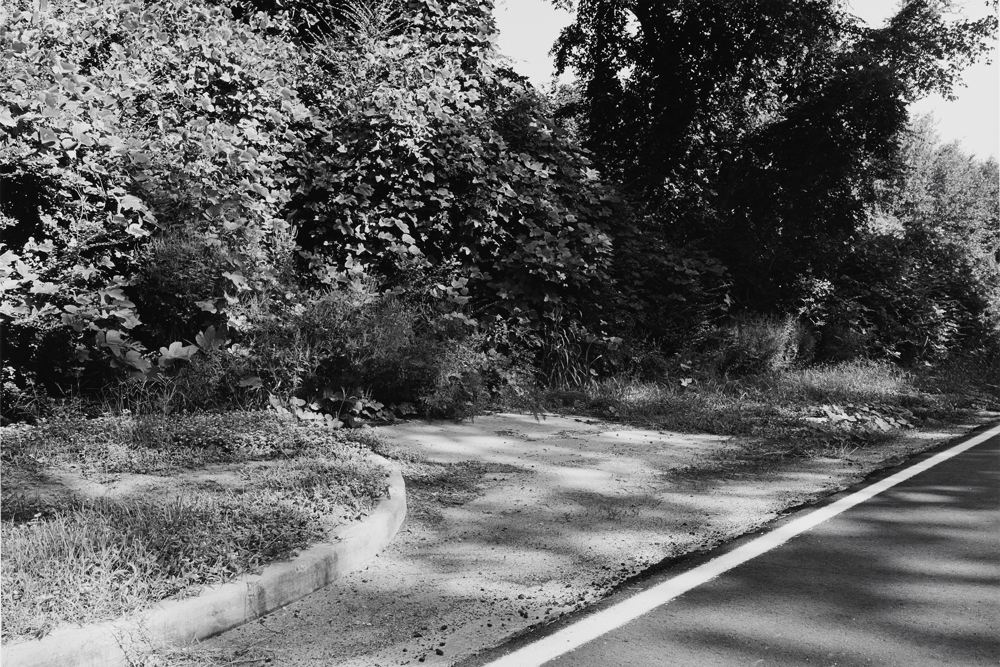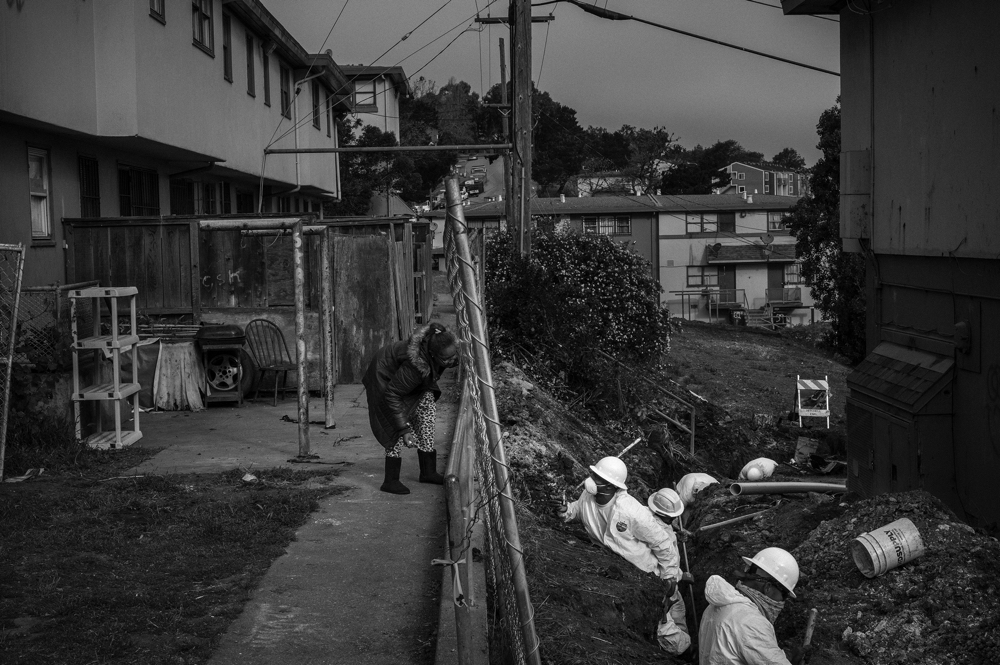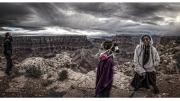“I wanted people to think about the homeland differently when it comes to the costs of war,” said Makeda Best. “We think everything is happening abroad, but it’s happening here too. It’s always been happening here.”
Best, the Harvard Art Museums’ Menschel curator of photography, was giving a tour of Devour the Land: War and American Landscape Photography since 1970. Opening today, it is the museums’ first major exhibition since the shutdown in March 2020. On display are more than 160 photographs, almost all drawn from the institution’s own collection. They offer a glimpse at the military’s footprint on American soil: a vast geography of environmental, economic, and social impacts that are profound—whole towns and industries went boom or bust—and often damaging, yet routinely unseen.
The subject has long preoccupied Best. Her 2020 book Elevate the Masses was a study of Civil War photographer Alexander Gardner, one of many photographers of his era who felt a special sensitivity to the natural landscape. “At that time, they even saw trees as wounded, in every sense of the destruction of modern warfare,” Best says. Gardner, in particular, was a pacifist and wrote even before the Civil War about how money spent on military combat ought to be used in different ways. The exhibition takes its name from an expression by Union general William Tecumseh Sherman, who wrote that his 1864 “march to the sea,” a literal scorched-earth campaign, would “devour the land” as he and his soldiers annihilated their way through the Confederacy, razing both military camps and civilian farmlands.
But for Best it's personal too: her mother worked for 30 years in the environmental-justice movement, as a speaker and organizer traveling the country, beginning with a garden she planted in the San Francisco jail where she was a counselor. It transformed into a farming program for inmates that helped reduce recidivism. “She was thinking about the connection between kids who don’t know what a grape is, who don’t eat greens, who feel disconnected from the earth, and jail or drug addiction,” Best says. “What does it do to a person, that disconnection, the fact that they’re living, literally, in a dump? It was kind of a strange childhood, but I always had this environmental awareness.”
The exhibition opens in the 1970s, with a wall of images documenting Americans’ complicated relationship with nuclear power and nuclear war: protesters and demonstrations, but also the ordinary people who worked as lab technicians in power plants. The famous picture by Robert Adams, “Burning oil sludge near Denver, Colorado,” is there—an image that Best says “announced a new moment in American landscape photography”—as well as pictures by lesser known artists, many of them women: “Photos that usually get put in the archives,” Best says. “I wanted to bring them into the conversation.”

Barbara Norfleet, American (b. Lakewood, NJ 1926), "Ellerton: the last traces of the town destroyed to build the Savannah River Plant, Savannah River Plant: 300 square miles, Aiken, SC, 1988." From the series The Landscape of the Cold War.
Harvard Art Museums, Gift of Barbara Norfleet, 2010.448.16. © Barbara Norfleet; image courtesy of the Harvard Art Museums.
The nuclear age and its consequences occupy a large portion of the exhibit: black-and-white depictions of abandoned Cold War installations, closed-off radiation zones, moonscape-looking weapons testing sites. One series of photographs from Barbara Norfleet, Ph.D. ’51, former curator of the Carpenter Center for the Visual Arts and a member of the Atomic Photographers Guild collective, shows the rotting structures of post-Cold War sites sitting empty: radioactive waste in California, an abandoned airfield in Florida, an ammunition plant that polluted the water in three Minnesota towns, a coyote standing in the distance of a radioactive site in Nevada. Norfleet’s handwritten captions hint at the immense scale of some of the places: 300 square miles, 725 square miles, 1,350 square miles.
Meanwhile, a pair of photographs by Navajo artist Will Wilson offer a stark juxtaposition. On the left is an image titled “Auto Immune Response: Confluence of Three Generations”; it shows him and his mother and daughter looking out across the Grand Canyon, which has a long history with the Navajo people. On the right is an aerial photograph of the Mexican Hat disposal cell, tucked into the Utah mountains; contains radioactive materials from a former uranium-ore-processing mill. The Navajo reservation 1.5 miles away has seen an increase in lung cancer, bone cancer, and kidney disease. “Wilson is contrasting this toxic pit with the sacred hills and speaking about time,” Best says. “In the Navajo cosmology, those hills have been here since forever. And now this toxicity will also be here forever.”
Many of the most affecting images in Devour the Land highlight the disproportionate effects on the poor and communities of color. Stacy Kranitz shows people living in the Baton Rouge neighborhood of Standard Heights, in a part of the country known as “Cancer Alley” because of the concentration of petrochemical plants. Standard Heights sits next to an Exxon oil refinery; the U.S. Department of Defense, Best explains, is the world’s largest consumer of fossil fuels. “And most of them are manufactured here.” Ashley Gilbertson, a war photographer, shows people fishing in polluted water and harvesting vegetables from polluted soil. “These people are living in this,” Best says. “It’s important to see that,” and to reckon with the idea not only of disease and devastation, but also everyday existence and how it unfolds in these damaged environments.

Ashley Gilbertson, Australian (b. Melbourne 1978), "A resident talks to workers in the Hunters Point neighborhood of San Francisco, California, on May 5, 2017, 2017." From the series Bombs in Our Backyard.
Harvard Art Museums, Fund for the Acquisition of Photographs, 2020.166. © Ashley Gilbertson/VII; image courtesy of the artist.
One of Gilbertson’s other photographs shows a resident of the Hunters Point neighborhood in San Francisco—near the shipyard that was once home to the Navy’s largest applied nuclear testing lab—leaning down to talk to a group of workmen who appear to be excavating a trench in her neighbor’s yard. “This just speaks so much about injustice,” Best says. “The woman doesn’t know what’s going on—no one has told her. The men have on these protective suits, but she doesn’t have anything. And you’ve got, like, a hanger attached to another fence to keep people out. That’s it. It all looks very haphazard. This is life in a polluted area.”
Best grew up not far away from where the photograph was taken. “My mother started community gardens in that area,” she says. “I went to school with a lot of kids from there who had asthma, who had a lot of disease in their family. And they had strange things that would come up in their yards—something would just kind of ooze out, and then people”—like the men in Gilbertson’s photograph—“would come and just dig a ditch and patch it up.”
Devour the Land also explores the idea of regeneration, and of the power of community organizing. Some of the show's photographs are unnervingly beautiful, others ironically humorous. “This exhibit asks us to think about what we don’t have oversight over and what we should have oversight over,” Best says. “And it asks us to think creatively about sustainability and about putting our energies toward solving some of this, instead of toward more weapons. These photographs remind us that what we do has consequences.”









